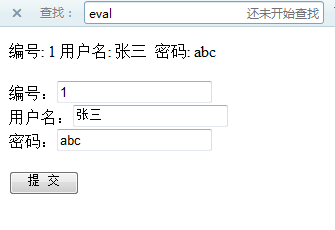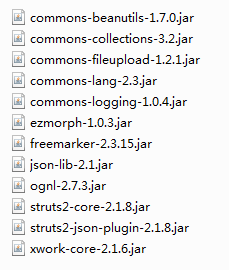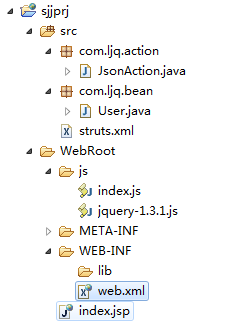struts2+jquery+json集成开发。
以下采用struts2+jquery+json模拟一个案例。当点击提交按钮时会把输入的数据提交到后台,然后从后台获取数据在客户端显示。
效果如下:

接下来为struts2+jquery+json集成步骤:
1、新建一个web工程,导入struts2+jquery+json所需jar,如下图

目录结构图

2、创建实体类User
package com.ljq.bean;
import java.io.Serializable;
@SuppressWarnings(“serial”) public class User implements Serializable { private int id; private String username; private String pwd;
public User() { }
public User(int id, String username, String pwd) { super(); this.id = id; this.username = username; this.pwd = pwd; }
public int getId() { return id; }
public void setId(int id) { this.id = id; }
public String getUsername() { return username; }
public void setUsername(String username) { this.username = username; }
public String getPwd() { return pwd; }
public void setPwd(String pwd) { this.pwd = pwd; }
}
import java.io.Serializable;
@SuppressWarnings(“serial”) public class User implements Serializable { private int id; private String username; private String pwd;
public User() { }
public User(int id, String username, String pwd) { super(); this.id = id; this.username = username; this.pwd = pwd; }
public int getId() { return id; }
public void setId(int id) { this.id = id; }
public String getUsername() { return username; }
public void setUsername(String username) { this.username = username; }
public String getPwd() { return pwd; }
public void setPwd(String pwd) { this.pwd = pwd; }
}
3、新建Action JsonAction
package com.ljq.action;
import net.sf.json.JSONObject;
import com.ljq.bean.User; import com.opensymphony.xwork2.ActionSupport;
@SuppressWarnings(“serial”) public class JsonAction extends ActionSupport{ private User user; // 返回结果给客户端 private String result; @Override public String execute() throws Exception { //将要返回的实体对象进行json处理 JSONObject json=JSONObject.fromObject(user); //输出格式如:{“id”:1, “username”:”zhangsan”, “pwd”:”123″} System.out.println(json); result=json.toString(); return SUCCESS; }
public User getUser() { return user; }
public void setUser(User user) { this.user = user; }
public String getResult() { return result; }
public void setResult(String result) { this.result = result; }
}
import net.sf.json.JSONObject;
import com.ljq.bean.User; import com.opensymphony.xwork2.ActionSupport;
@SuppressWarnings(“serial”) public class JsonAction extends ActionSupport{ private User user; // 返回结果给客户端 private String result; @Override public String execute() throws Exception { //将要返回的实体对象进行json处理 JSONObject json=JSONObject.fromObject(user); //输出格式如:{“id”:1, “username”:”zhangsan”, “pwd”:”123″} System.out.println(json); result=json.toString(); return SUCCESS; }
public User getUser() { return user; }
public void setUser(User user) { this.user = user; }
public String getResult() { return result; }
public void setResult(String result) { this.result = result; }
}
4、建立struts.xml文件
<?xml version=”1.0″ encoding=”UTF-8″ ?> <!DOCTYPE struts PUBLIC “-//Apache Software Foundation//DTD Struts Configuration 2.0//EN” “http://struts.apache.org/dtds/struts-2.0.dtd”> <struts> <!– 该属性指定需要Struts2处理的请求后缀,该属性的默认值是action,即所有匹配*.action的请求都由Struts2处理。 如果用户需要指定多个请求后缀,则多个后缀之间以英文逗号(,)隔开。 –> <constant name=”struts.action.extension” value=”do” /> <!– 设置浏览器是否缓存静态内容,默认值为true(生产环境下使用),开发阶段最好关闭 –> <constant name=”struts.serve.static.browserCache” value=”false” /> <!– 当struts的配置文件修改后,系统是否自动重新加载该文件,默认值为false(生产环境下使用),开发阶段最好打开 –> <constant name=”struts.configuration.xml.reload” value=”true” /> <!– 开发模式下使用,这样可以打印出更详细的错误信息 –> <constant name=”struts.devMode” value=”true” /> <!– 默认的视图主题 –> <!– <constant name=”struts.ui.theme” value=”simple” /> –> <!– <constant name=”struts.objectFactory” value=”spring” /> –> <package name=”test” extends=”json-default”> <action name=”jsonAction” class=”com.ljq.action.JsonAction”> <result type=”json”> <!– 此处将reslut的值返回给客户端,root的值对应要返回的值的属性result 注意:root为固定写法,否则不会把result的值返回给客户端 –> <param name=”root”>result</param> </result> </action> </package>
</struts>
</struts>
5、编写index.jsp文件
<%@ page language=”java” import=”java.util.*” pageEncoding=”UTF-8″%> <%@taglib uri=”/struts-tags” prefix=”s”%> <% String path = request.getContextPath(); String basePath = request.getScheme() + “://” + request.getServerName() + “:” + request.getServerPort() + path + “/”; %>
<!DOCTYPE HTML PUBLIC “-//W3C//DTD HTML 4.01 Transitional//EN”> <html> <head> <base href=”<%=basePath%>”>
<title>My JSP ‘index.jsp’ starting page</title> <meta http-equiv=”pragma” content=”no-cache”> <meta http-equiv=”cache-control” content=”no-cache”> <meta http-equiv=”expires” content=”0″> <meta http-equiv=”keywords” content=”keyword1,keyword2,keyword3″> <meta http-equiv=”description” content=”This is my page”> <script type=”text/javascript” src=”<%=request.getContextPath() %>/js/jquery-1.3.1.js”></script> <script type=”text/javascript” src=”<%=request.getContextPath() %>/js/index.js”></script> <!– <s:head theme=”ajax” />这句话好像没影响哦 –> <!– <s:head theme=”ajax” />–> <!–在jsp页面上加入<s:head theme=”ajax” />会报如下异常:java.io.FileNotFoundException: Template /template/ajax/head.ftl not found. 解决办法:在struts2-core-2.1.8.jar/template目录下加入ajax文件夹,ajax文件夹所在目录为 struts2-core-2.1.8.jar/template/archive。 注意:ajax文件夹下要包含head.ftl,否则还是会抛异常。head.ftl请在template目录搜索然后放到ajax文件夹里 –> </head>
<body> <!– 显示User实体对象 –> <div id=”result”></div> <s:form name=”userForm” action=”/jsonAction.do” method=”post”> 编号:<input name=”user.id”/><br/> 用户名:<input name=”user.username”/><br/> 密码:<input name=”user.pwd”/><br/><br/> <input id=”btn” type=”button” value=” 提 交 “/> </s:form>
</body> </html>
<!DOCTYPE HTML PUBLIC “-//W3C//DTD HTML 4.01 Transitional//EN”> <html> <head> <base href=”<%=basePath%>”>
<title>My JSP ‘index.jsp’ starting page</title> <meta http-equiv=”pragma” content=”no-cache”> <meta http-equiv=”cache-control” content=”no-cache”> <meta http-equiv=”expires” content=”0″> <meta http-equiv=”keywords” content=”keyword1,keyword2,keyword3″> <meta http-equiv=”description” content=”This is my page”> <script type=”text/javascript” src=”<%=request.getContextPath() %>/js/jquery-1.3.1.js”></script> <script type=”text/javascript” src=”<%=request.getContextPath() %>/js/index.js”></script> <!– <s:head theme=”ajax” />这句话好像没影响哦 –> <!– <s:head theme=”ajax” />–> <!–在jsp页面上加入<s:head theme=”ajax” />会报如下异常:java.io.FileNotFoundException: Template /template/ajax/head.ftl not found. 解决办法:在struts2-core-2.1.8.jar/template目录下加入ajax文件夹,ajax文件夹所在目录为 struts2-core-2.1.8.jar/template/archive。 注意:ajax文件夹下要包含head.ftl,否则还是会抛异常。head.ftl请在template目录搜索然后放到ajax文件夹里 –> </head>
<body> <!– 显示User实体对象 –> <div id=”result”></div> <s:form name=”userForm” action=”/jsonAction.do” method=”post”> 编号:<input name=”user.id”/><br/> 用户名:<input name=”user.username”/><br/> 密码:<input name=”user.pwd”/><br/><br/> <input id=”btn” type=”button” value=” 提 交 “/> </s:form>
</body> </html>
6、建立文件index.js
$(document).ready(function(){ //点击提交按钮时,从服务端获取数据,然后在客户端显示 $(“#btn”).click(function(){ // 序列化表单的值 var params=$(“input”).serialize(); $.ajax({ url: “jsonAction.do”, // 数据发送方式 type: “post”, // 接受数据格式 dataType : “json”, // 要传递的数据 data : params, // 回调函数,接受服务器端返回给客户端的值,即result值 success : show }); }); }); function show(result){ //测试result是否从服务器端返回给客户端 //alert(result); //解析json对象 var json = eval(“(“+result+”)”); var obj = “编号: “+json.id+” 用户名: “+json.username+” 密码: “+json.pwd; $(“#result”).html(obj); }
